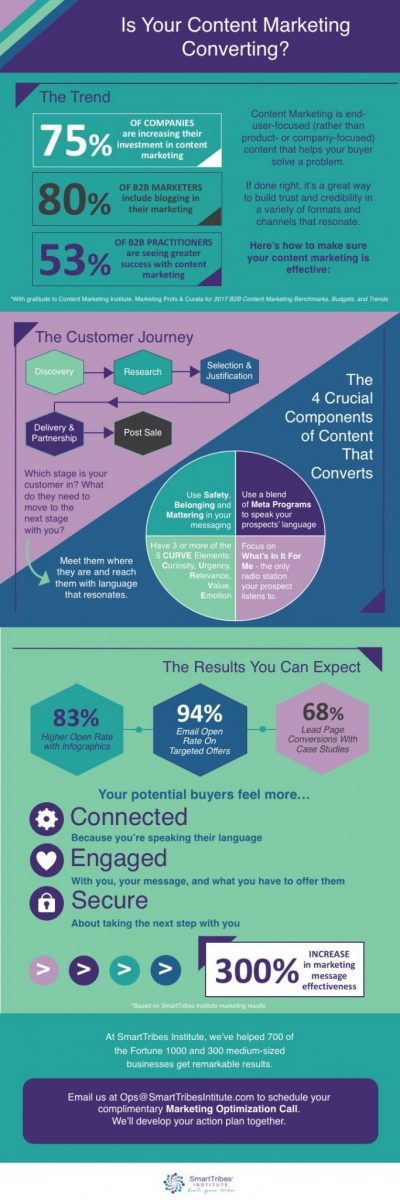
*As originally seen on Forbes.com
The Content Marketing Institute together with Marketing Profs and Curata released an essential study recently.
You need to read it.
Why? Because it found that 75% of companies are increasing their investment in content marketing, and 43% are increasing staff levels. Content marketing works, and I’ll show you how and why in the next 3 minutes.
Chief marketing officers have repeatedly recognized the need for a core content marketing team. And this team doesn’t need to be led by a CCO — chief content officer — a role which is being retired at many companies. Instead the successful content leader typically has a marketing operations manager or writer/editor title. Their job is to develop and orchestrate a content strategy across the company.

What’s Your Marketing Mix? Credit: Bluewire Media http://www.bluewiremedia.com.au/web-strategy-planning-template
Content Marketing Works
Content marketing is all about non-egocentric (i.e., end-user-focused rather than product- or company-focused) content that helps buyers with their jobs and careers. This content adds value—that’s why it works. Yes, you can include a smidge of product content woven in with the value-based message. Also be sure to publish via multiple content channels. As a result you will speed up the process of providing the necessary nine to twelve high value touches, which is a rough standard for B2B conversions for marketing efforts.
Four Keys To Successful Content
1. Use SBM (safety, belonging, mattering) in your messaging
2. Use meta-programs: when you have a blend of different meta-programs you need to use them all, since the brain deletes information not relevant to it. The good news is that this actually works!
4. Have three or more of the five curve elements:
C for Curiosity: does the content make the recipient curious?
U for Urgency: does the content make the recipient want to take action?
R for Relevance: is the content relevant to the recipient’s situation or context?
V for Value: does the content reflect the recipient’s values and/or is it valuable to the recipient?
E for Emotion: does the content evoke emotions in the recipient? Is it funny, fascinating, surprising…?
In addition to multiple channels you’ll also want to repurpose your content to ensure your reach is to the greatest potential relevant audience. As we know, if you only post one type of content in one specific way, you are only reaching a small percentage of your entire audience and potential prospective customer base. Let’s look at some examples of content marketing that worked.

Blogs
According to Content Marketing Institute, 80% of B2B marketers include blogging in their marketing and 53% of B2B practitioners say they are achieving greater success now than in previous years. They attribute that increase to spending more time on content marketing, which includes blogs. The trend from “snackable content” to “sumptuous feasts” is rising. Consumers want to trust their information sources and are expecting that content be researched, accurate and worthy of their time and attention.
After many years of blogging, I have found that posting value-added blogs, on a regular basis, continues to deeply resonate with my audience. Based on views and comments, I am able to determine which blog content resonates the most and repurpose this information so that it can be shared on different channels and in different ways (infographic, SlideShare etc.) to reach a larger audience. When you create content that works well, reuse it in at least six different ways (including webinar, podcast, guest blog, video, etc).
Infographics
One of my clients posted their first infographic on LinkedIn. It had 3,674 views in the first 72 hours, which resulted in 22 leads. Conversations are now in process and we’ll see how many of those convert. Next, they emailed the infographic out to their list and had open rates 83% higher than usual.
Emails
One of my company’s clients held a reception after a conference and had a goal of setting up meetings with those that attended. He sought my help in crafting an email that would compel the recipients to agree to a meeting. After we edited the message, using a blend of different meta-programs, this email received a 20% response rate—meaning 20% of the recipients agreed to the call to action (CTA), which was a meeting with our client. This was a new record for the company!
We created a case study that celebrated the success of one of our clients. We used a combination of channels to distribute this information. First, we posted the case study to LinkedIn with a CTA that took the recipient to a LeadPage. The LeadPage had a CTA asking them to opt-in to our list to receive one of the resources that was mentioned in the successful case study of our client. The conversion of the LeadPage was 68.5%. The automated email that we sent out to those that opted in (which contained the value added resource promised) had a 92.9% open rate and 82.1% click rate. These numbers, combined with the feedback from those that received the resource, showed us that our content, which combined safety/belonging/mattering, meta-programs and high-value, resonated with our audience.
Slideshare
We started using SlideShare 90 days ago. We have posted two presentations that contained content that was repurposed from popular blog posts, and have had a total of 2,672 views. Our one presentation had over 300 views over the course of two days. We now know that SlideShare is a social media channel that resonates with our audience and will continue to post on a more frequent basis and test different CTAs to determine what resonates the most with our audience and what is compelling them to convert.






